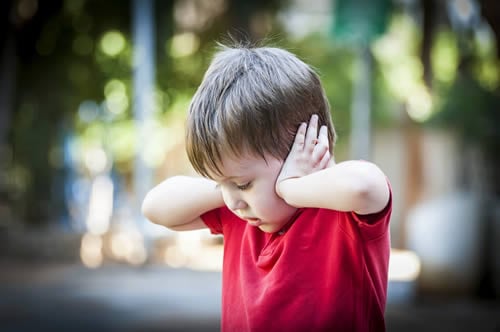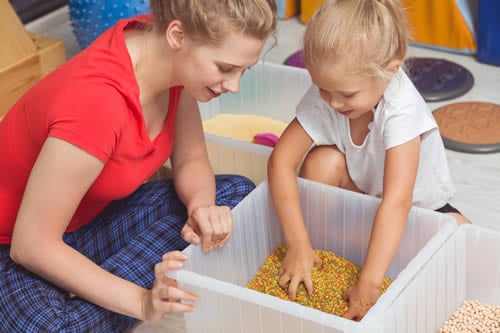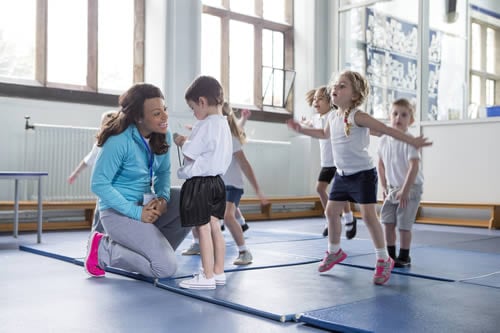If you’ve ever winced at the sound of a fingernail scraping a blackboard or shuddered at the texture of a spoonful of rice pudding, you’ll know what it’s like to be overwhelmed by an unpleasant sensory experience. Conversely, maybe you love the feel of velvet or find it relaxing to listen to the sound of raindrops falling on leaves in the garden.
As humans, we all experience the world through our senses and it’s natural to find some sensations more tolerable than others. But for many people with special needs, disordered sensitivity to touch, vision, sound, taste and smell is a big part of their everyday experience and can interfere with their ability to function or learn new things.
Sensory Issues Connected to Special Needs

These difficulties nearly always go hand-in-hand with a neurodevelopmental disorder such as autism, dyspraxia or ADHD and can also be caused by a brain injury or emotional and mental health challenges says Denise Jemil, a highly experienced paediatric occupational therapist from Kent and the mum of a young man with ASD.
People with sensory issues, she says, can be over-sensitive to stimulus – hating loud noises, for example, or finding a scratchy label in an item of clothing unbearable. They may also be under-sensitive – needing additional sensory input, such as a squeezy stress-ball or coloured lights, in order to feel calm. Sometimes, they are both under and over-sensitive in different ways.
Alongside these sensitivities, Jemil explains, people very often have problems with their proprioceptive and vestibular systems. “The proprioceptive system tells you where your body is in relation to your environment while the vestibular system deals with balance, the ear and where your head is in relation to your body. Vision also comes into this.”
“Sensory processing is a very complex area,” she adds. “People can also have problems sensing pain, regulating temperature, discriminating between different sensations or even identifying the direction of sound.”
The School Environment and Sensory Needs

Tutor Marissa also has a son with special needs and researched sensory processing disorder as part of her teaching degree. “Sensory difficulties can massively affect a child’s learning,” she comments. “When you’re in the classroom, the children who have sensory issues are easily recognised. Children with proprioceptive problems, for example, might have difficulties with handwriting, sitting still, lining up or need to touch and chew things. Children with problems with their vestibular system may spin, bump into other people, rock back and forth or find it difficult to copy work from the board.”
It’s essential, she says, for teachers to cater for these sensory needs with, for example, short ‘brain breaks’ during the school day where children take part in fun, sensory activities. These could include using:
- Weighted blankets
- Squishing Plasticene
- Crunching carrots
- Dancing, playing on a swing or crawling across an obstacle course
Doing so, she maintains, helps children become calmer and to focus much better on formal learning tasks. “The trick is noticing which children would benefit most from which activity and observing each child’s behaviour to pinpoint when to introduce the correct activity,” she advises.
A Sensory Diet Boosts Learning

Fellow-tutor Alicia has worked in a special school and has a lot of experience of kids with autism. She agrees that providing sensory games and tasks is extremely important for children with SEN.
“It’s absolutely key,” she asserts. “If that’s not right, they’ll be blocked from learning. I had one pupil, for example, who used to slam himself against a cupboard because he needed that feeling of deep pressure. Finding sensory activities that engage children can help them to learn better and be more cooperative. I like to use an imaginative approach. You can devise a sensory circuit, for example, where children do star jumps, throw a soft toy, slide along a wall or lie on a mat looking at coloured lights.
“I also like to hide letters in foam and get the children to find them,” she carries on. “I hide numbers round the classroom and get the kids to run around and find them, too.”
Sensory Issues Are Individual
Every person’s sensory profile is completely unique, Denise Jemil points out. “It’s a spectrum. I’ve worked in this area for twenty-five years and every child I meet is ‘new’. It’s imperative to have a child’s sensory needs formally assessed as early as possible,” she cautions, “otherwise there’s a danger they will develop anxiety and depression further down the line. The more someone knows about a disorder, the more control they have over their life.”




